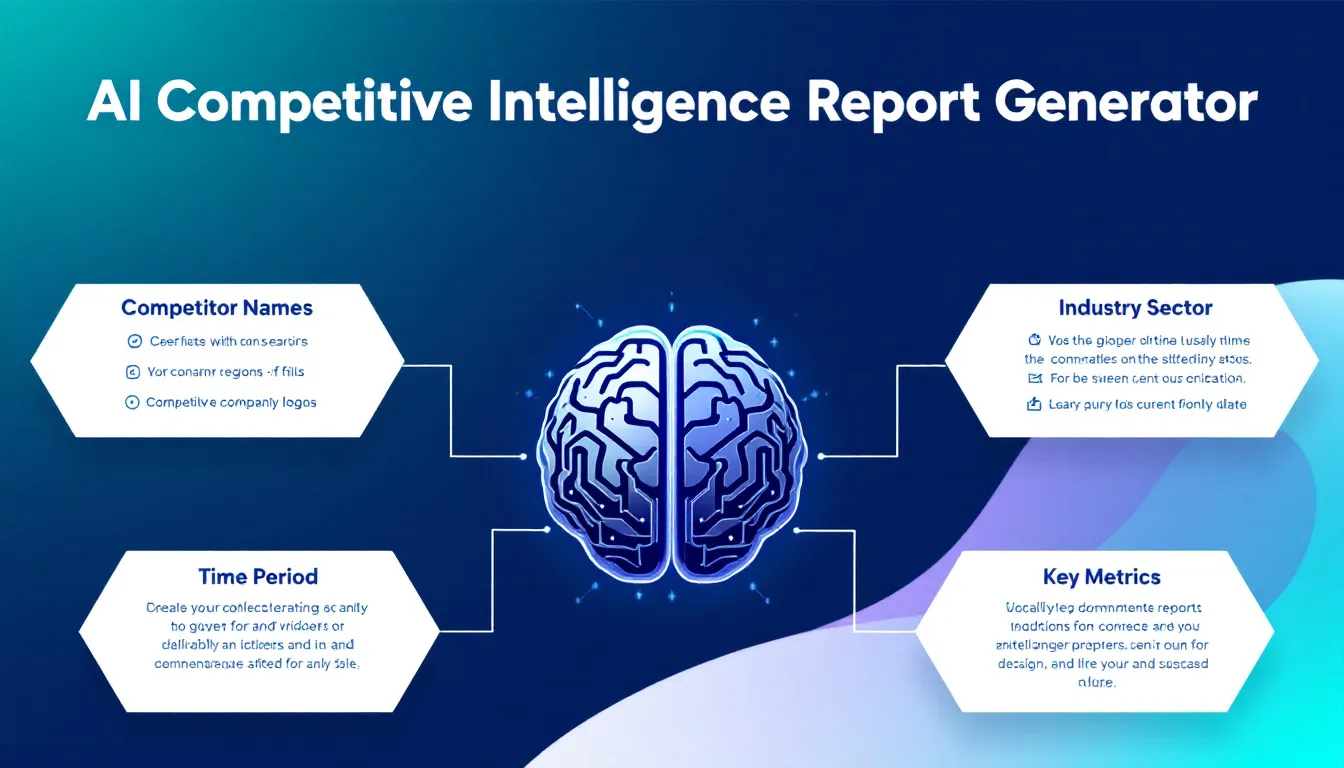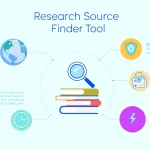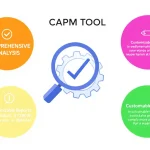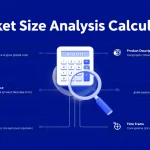AI Competitive Intelligence Report Generator
Is this tool helpful?
How to Use the AI Competitive Intelligence Report Generator Effectively
This AI-powered tool helps you generate detailed competitive intelligence reports quickly. To get accurate and useful insights, fill out the fields carefully. Here’s a clear guide on what to enter in each field with sample inputs different from what you might see in the form.
Input Field Guide
-
Competitor Names: Enter competitor company names, one per line. Examples:
- Zoom Video Communications Inc.
- Slack Technologies LLC
- Microsoft Teams
-
Industry Sector: Specify the exact segment your business operates in. Examples:
- “Renewable Energy Solutions”
- “Online Education Platforms”
-
Time Period: Define the exact timeframe you want the analysis to cover. Examples:
- “April 2022 – March 2023”
- “H1 2021 – H2 2023”
-
Metrics to Analyze: List specific business performance indicators. Examples:
- “Customer retention rate, net promoter score, average order value”
- “Churn rate, operational costs, marketing ROI”
Optional Fields
-
Geographic Region: Specify the market location if you want region-specific insights. Examples:
- Asia-Pacific
- South America
-
Data Sources: Include URLs for relevant public or proprietary reports. Examples:
- https://industryreports.com/clean-tech-2023
- https://marketdata.gov/ecommerce-trends
Introduction to the AI Competitive Intelligence Report Generator
The AI Competitive Intelligence Report Generator helps you analyze your competitors and market trends efficiently. By leveraging artificial intelligence, it transforms raw data into insightful, actionable reports tailored to your industry and business goals. This tool saves you time by automating data collection and analysis while providing a comprehensive view of your competitive landscape.
You benefit from streamlined strategic decisions, clear identification of growth opportunities, and improved understanding of market dynamics — all in one platform.
Practical Usage of the Competitive Intelligence Report Generator
This tool works by processing the inputs you provide, such as competitor names, industry sector, timeframe, and key metrics. It then generates a detailed report that highlights competitive positioning, market trends, and performance benchmarks.
Example Market Analysis Scenario
Imagine you want to analyze three companies in the renewable energy sector for the period January 2021 to December 2023. You might enter the following competitors and metrics:
- Competitors: SunPower Corp., First Solar Inc., Enphase Energy
- Metrics: revenue, installed capacity (MW), R&D expenditure
Based on this information, the tool will calculate market shares and growth rates, helping you see which company leads in revenue and innovation.
Key Formulas Used in Analysis
The generator applies proven mathematical models to turn raw data into meaningful insights:
-
Market Share Calculation:
$$Market\ Share = \frac{Company\ Revenue}{Total\ Market\ Revenue} \times 100$$ -
Competitive Position Index:
$$Competitive\ Position\ Index = \sum_{i=1}^{n} \left(w_i \times \frac{Company\ Metric_i}{Industry\ Best\ Metric_i}\right)$$ -
Compound Annual Growth Rate (CAGR):
$$Growth\ Rate = \left(\frac{Ending\ Value}{Starting\ Value}\right)^{\frac{1}{n}} – 1$$
Using Reports to Solve Business Intelligence Challenges
The competitive intelligence report provides critical insights for strategic decisions, such as identifying market leaders, spotting growth opportunities, or assessing competitive threats.
For example, tracking market share changes over your defined time period shows shifts in customer preference or effectiveness of marketing campaigns.
Benefits of Using the AI Competitive Intelligence Report Generator
- Save Time: Automate gathering and analyzing competitor data instead of manual research.
- Comprehensive Insights: Evaluate multiple competitors across diverse industry metrics simultaneously.
- Strategic Decision Support: Gain clear metrics to guide pricing, marketing, and product strategies.
- Customizable Reports: Tailor reports to your industry sector, geographic markets, and specific KPIs.
- Data-Driven Actions: Base your business moves on quantified market trends and competitor benchmarks.
Practical Applications and Use Cases
Strategic Business Planning
- Identifying new market opportunities based on competitor weaknesses.
- Formulating entry strategies for untapped markets.
- Optimizing product positioning in competitive landscapes.
Investment and Acquisition Support
- Assessing valuation and growth potential of acquisition targets.
- Conducting feasibility studies for geographic expansion.
- Evaluating synergies between competitors and your business.
Performance Benchmarking
Benchmark your company’s performance against competitors using customized weighted scores:
-
Benchmark Score Calculation:
$$Benchmark\ Score = \sum_{i=1}^{n} \frac{Actual\ Performance_i}{Target\ Performance_i} \times Weight_i$$
Frequently Asked Questions About Competitive Intelligence Reports
What types of competitors can I analyze?
You can analyze public and private companies, direct competitors, or indirect industry players. The tool handles companies of different sizes and across multiple sectors.
How many competitors should I list?
Include 3 to 10 relevant competitors for focused and actionable insights. This ensures the report remains clear and manageable.
Can I include international competitors?
Yes. Specify geographic regions in the optional field to tailor analysis based on global or regional markets.
Which metrics should I focus on for best results?
Choose metrics aligned with your strategic goals: revenue, customer satisfaction, innovation metrics, operational costs, and market share are common examples.
How do I improve the quality of reports?
Provide accurate inputs, relevant metrics, and useful data sources. More detailed and precise information yields more valuable outcomes.
Can I analyze different timeframes?
Yes. Set any time period that captures meaningful business cycles or market trends, such as quarterly, yearly, or multi-year spans.
How do I interpret the report results?
Look at trends, relative performance against competitors, and highlighted opportunities. The report combines numbers with contextual insights for clear understanding.
What data source formats does the tool support?
You can provide URLs for industry reports, public datasets, and market analyses in formats like PDF, HTML, or structured data feeds.
Advanced Analytical Features
Trend Analysis
The tool detects market momentum and growth patterns using trend strength calculations:
- $$Trend\ Strength = \frac{\sum_{i=1}^{n} (x_i – \bar{x})(i – \bar{i})}{\sqrt{\sum_{i=1}^{n} (x_i – \bar{x})^2 \sum_{i=1}^{n} (i – \bar{i})^2}}$$
Market Sentiment Analysis
By analyzing positive and negative mentions using natural language processing, the tool generates sentiment scores to gauge public perception:
- $$Sentiment\ Score = \frac{Positive\ Mentions – Negative\ Mentions}{Total\ Mentions}$$
This helps you understand brand reputation and competitive positioning beyond just financial data.
Important Disclaimer
The calculations, results, and content provided by our tools are not guaranteed to be accurate, complete, or reliable. Users are responsible for verifying and interpreting the results. Our content and tools may contain errors, biases, or inconsistencies. Do not enter personal data, sensitive information, or personally identifiable information in our web forms or tools. Such data entry violates our terms of service and may result in unauthorized disclosure to third parties. We reserve the right to save inputs and outputs from our tools for the purposes of error debugging, bias identification, and performance improvement. External companies providing AI models used in our tools may also save and process data in accordance with their own policies. By using our tools, you consent to this data collection and processing. We reserve the right to limit the usage of our tools based on current usability factors.







